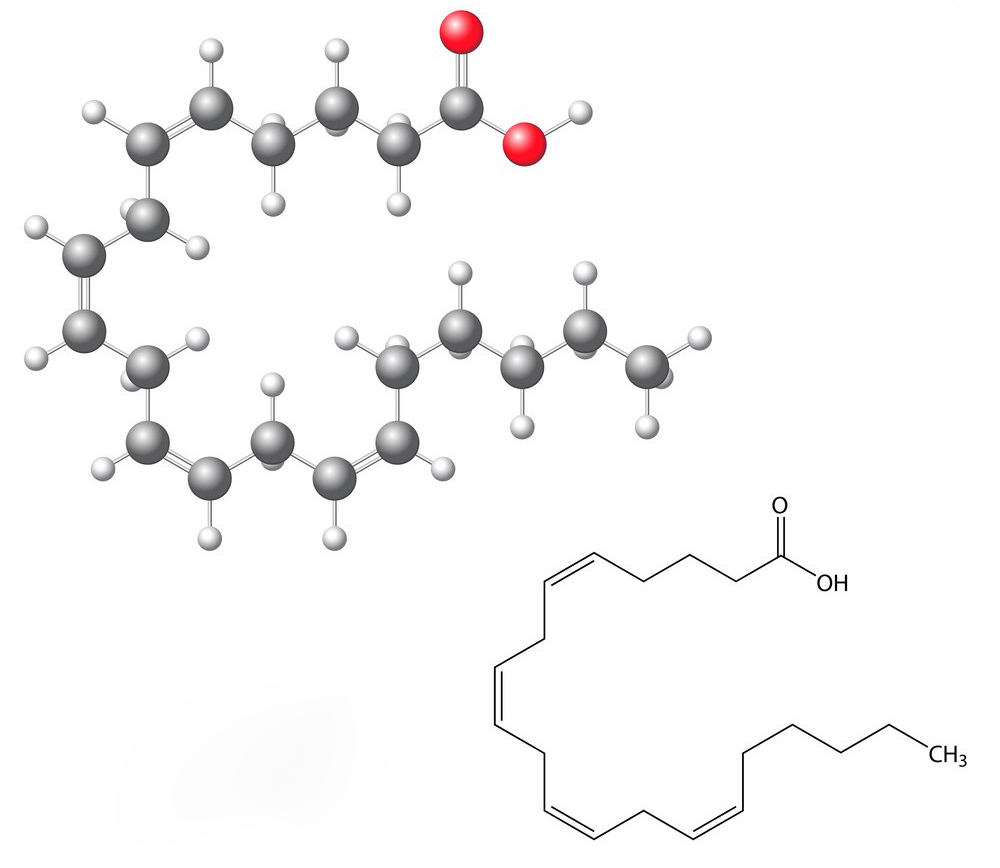Arachidonic Acid (AA) is a polyunsaturated omega-6 fatty acid with a 20-carbon chain and four double bonds. Its chemical structure is as follows:
CH3(CH2)4(CH=CH-CH2)4(CH2)3COOH
Physical properties of Arachidonic Acid:
Molecular formula: C20H32O2
Molecular weight: 304.47 g/mol
Melting point: -49 °C
Boiling point: 160-165 °C at 1.0 mmHg
Solubility: Arachidonic Acid is sparingly soluble in water, but it is soluble in organic solvents like ethanol, chloroform, and ether.
Appearance: At room temperature, it is a colorless to pale yellow liquid.

Arachidonic Acid is an essential fatty acid, meaning it is not synthesized in the human body and must be obtained through the diet. It plays a crucial role in various physiological processes, including being a precursor for the synthesis of certain signaling molecules called eicosanoids. Eicosanoids include prostaglandins, thromboxanes, and leukotrienes, which have important roles in inflammation, blood clotting, and immune response regulation.
It is worth noting that my knowledge is based on information available up to September 2021, and there might have been new research findings or updates beyond that date.
Applications of Arachidonic Acid
Arachidonic Acid (AA) is a polyunsaturated omega-6 fatty acid that plays a crucial role in various physiological processes, particularly in the production of eicosanoids, which are bioactive lipid molecules involved in inflammation and immune responses. AA is obtained from the diet and can also be synthesized in the body from linoleic acid. Clinical applications of Arachidonic Acid involve its role in various health conditions and therapeutic interventions. Here are some important clinical applications:
Inflammation and Immune Response: Arachidonic Acid serves as a precursor for the production of prostaglandins, thromboxanes, and leukotrienes, which are potent mediators of inflammation and immune responses. These molecules are involved in the regulation of vasodilation, vascular permeability, platelet aggregation, and the recruitment of immune cells to sites of injury or infection. Drugs that inhibit or modulate the activity of these eicosanoids are used to treat inflammatory conditions like rheumatoid arthritis, inflammatory bowel diseases, and asthma.
Cardiovascular Health: Arachidonic Acid-derived eicosanoids, such as thromboxane A2, play a role in platelet aggregation and vasoconstriction, which can contribute to cardiovascular diseases. Inhibition of Arachidonic Acid metabolism is used in the treatment of conditions like thrombosis, myocardial infarction, and peripheral vascular disease.
Mental Health: There is emerging evidence suggesting that Arachidonic Acid and its metabolites may have implications for mental health and neurological disorders. For instance, some studies have explored the relationship between omega-6 fatty acids, including Arachidonic Acid, and conditions like depression and bipolar disorder. However, more research is needed in this area to fully understand the role of Arachidonic Acid in mental health.

Skin Health: Arachidonic Acid is an essential component of the epidermal lipid barrier, and its metabolites are involved in regulating skin hydration and inflammation. Topical formulations containing Arachidonic Acid or its derivatives are used in skincare products to help maintain skin health and manage certain skin conditions.
Infant Development: Arachidonic Acid is important for the growth and development of infants, particularly for brain development. It is found in breast milk, and commercial infant formulas are supplemented with Arachidonic Acid to support the healthy development of infants who are not breastfed.
Prostaglandin E1 (PGE1) Therapy: PGE1, which is derived from Arachidonic Acid, has been used as a therapeutic agent for various conditions, including erectile dysfunction, peripheral vascular disease, and certain types of pulmonary hypertension.
It is important to note that while Arachidonic Acid is essential for various physiological processes, an excess of Arachidonic Acid can also contribute to inflammatory conditions and certain diseases. Therefore, maintaining an appropriate balance of omega-6 and omega-3 fatty acids in the diet is crucial for overall health.
As with any medical intervention, clinical applications of Arachidonic Acid and its derivatives should be carefully assessed, and treatment decisions should be made in consultation with qualified healthcare professionals.
